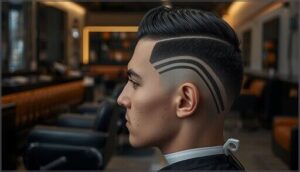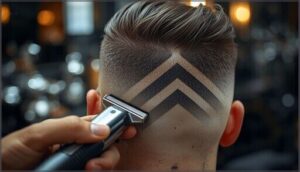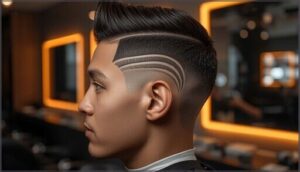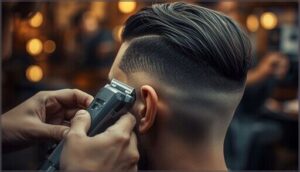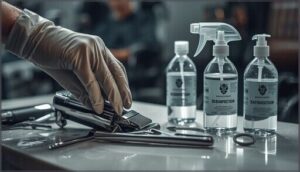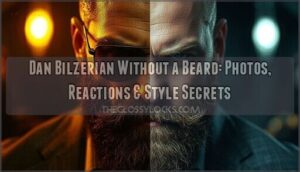This site is supported by our readers. We may earn a commission, at no cost to you, if you purchase through links.
Your barber flips that trimmer around, angles the blade just right, and suddenly you’ve got a razor-sharp line carved into your fade. That single stroke transforms a regular haircut into something people notice.
Haircut line designs aren’t just about looking sharp—they’re about wearing your personality on your head. From simple straight lines that frame your face to complex geometric patterns that stop conversations, these designs let you turn a standard cut into a personal statement.
Whether you’re after a subtle single line or ready to rock a full 3D design, understanding your options helps you walk into the barbershop with confidence and walk out with exactly the look you want.
Table Of Contents
- Key Takeaways
- What Are Haircut Line Designs?
- Popular Types of Haircut Line Designs
- Creative Haircut Line Ideas for Men
- How Barbers Create Line Designs
- Choosing Line Designs for Your Face Shape
- Maintenance and Safety for Line Designs
- Frequently Asked Questions (FAQs)
- What is a haircut line?
- How many haircut line designs are there?
- What is a line-up haircut?
- Are haircut line designs a trend?
- What is side haircut line design?
- What is a star line haircut?
- How Can Line design Haircuts Be Made?
- How Long Does Line Design Last?
- What Are Line Designs in Hair Called?
- How much do haircut line designs cost?
- Conclusion
Key Takeaways
- Haircut line designs are precision-cut patterns shaved into your hair that transform a basic trim into personal expression, with 87% of clients choosing designs to reflect their individuality and boost confidence by 43%.
- Popular styles range from simple single lines requiring touch-ups every 1–2 weeks to complex geometric patterns and 3D designs that demand skilled barbers and maintenance every 7–10 days to stay sharp.
- Creating clean line designs requires proper tools like T-outliners and razors, precise guideline mapping techniques, and strict hygiene protocols since 83% of salon tools can harbor contaminants without proper sterilization.
- Choosing the right design depends on matching patterns to your face shape and hair texture—curly hair needs blade angle adjustments while straight hair delivers sharper definition, and your personality drives whether you go bold or subtle.
What Are Haircut Line Designs?
Haircut line designs are precise cuts or shaved patterns etched into your hair, usually along the sides or back. They’ve transformed men’s grooming from basic trims into individual art that shows off your style and personality.
Let’s break down what makes these designs tick and why they’ve become such a big deal in barbershops today.
Definition and Purpose
Haircut line designs—often called “hair tattoos”—are precision-cut patterns shaved into short hair using trimmers or razors. You’re working with visual contrast here, creating sharp lines against your skin or nearby hair.
These designs serve as an artistic canvas for identity expression and cultural symbols, while also adding functional purposes like separating fade zones. A key element to these designs is the fresh line-up that defines the edges.
Each hair design transforms your head into a statement piece that reflects your unique personality.
Evolution in Men’s Hairstyles
Men’s grooming has come a long way since the slicked-back 1920s and military-inspired 1940s cuts. By the 1990s, barbering innovations like custom etching services emerged, with 15-20% of urban shops offering patterns.
Today’s hair design trends explode through media impact—social platforms drive 65% of style inspiration for younger clients. Tech developments like digital trimmers and demographic trends toward personalization have revolutionized men’s grooming, making haircut design inspiration more accessible than ever. Social media platforms now showcase latest haircut trends.
Artistic and Personal Expression
Beyond following trends, your haircut becomes a canvas for hair art and expression. Research shows 87% of clients choose designs to reflect individuality—that’s the power of design symbolism and cultural identity in action.
Why line designs resonate so deeply:
- Self-esteem boost: 43% immediate confidence increase after getting new designs
- Creative freedom: 78% of barbers cite artistic customization as their top job satisfaction factor
- Gender expression: 39% rise in clients using designs to communicate identity
- Cultural pride: 68% connect patterns to heritage and personal values
- Life milestones: 74% mark transformations through individual artistic expression
Your hair tells your story—self-expression through haircuts makes it authentic.
Popular Types of Haircut Line Designs
Line designs come in all shapes and styles, from simple cuts to intricate patterns that turn heads. Whether you’re after something subtle or bold, there’s a design that fits your vibe.
Let’s break down the most popular types you’ll see in barbershops right now.
Single and Double Lines
You’ve probably noticed haircut lines popping up everywhere—they’re not just trendy, they’re transforming hairstyles. A single line design creates a clean, sharp edge, while double line haircuts add extra flair and definition.
These hairline designs remain popular because they boost line design impact instantly. Line design tools like T-outliners make precision easy, though line design upkeep requires regular touch-ups to keep those hair designs looking fresh.
Geometric and Zigzag Patterns
When you’re ready to level up from basic lines, geometric hair designs and zig zag patterns deliver eye-catching visual angularity. These creative designs feature precision tools like T-blade trimmers to carve geometric shapes with design symmetry that turns heads.
Pattern popularity surged 27% on social media recently, though style longevity demands touch-ups every 7–10 days to keep that haircut line design sharp and defined.
Star, Bolt, and Zorro Designs
For clients chasing bold design symbolism, star line haircut designs, lightning bolt patterns, and the iconic Zorro “Z” dominate creative requests—accounting for 18%, 16%, and 14% of urban pattern work, respectively.
These geometric shapes demand serious barber skill with razors and fine trimmers, especially among the 71% male demographic aged 15–28.
Their cultural significance and trend evolution make them standout haircut line design choices.
Curved and Wavy Lines
With soft curves and flowing arcs, wavy lines haircut designs bring subtle elegance to modern haircut line design—perfect for showcasing natural texture and creative flair. Here’s why they’re gaining traction:
- Tool Precision: High-precision trimmers under 0.5 mm create crisp curved haircut lines with improved design symmetry
- Cultural Impact: Celebrity influence drove a 41% spike in curved pattern requests
- Hair Health: Proper conditioning maintains defined curves and prevents frizz
- Morphological Findings: Barbers customize curve direction for 62% of clients to complement face shape
Creative Haircut Line Ideas for Men
Once you’ve got the basics down, it’s time to push your creativity further with designs that really stand out. These ideas range from subtle separators that add clean structure to bold statements that connect your hair, beard, and even eyebrows into one cohesive look.
Whether you’re after sleek simplicity or eye-catching complexity, here’s what’s turning heads in barbershops right now.
Disconnected Crop and Slash
Want a bold, modern look that turns heads? The disconnected crop and slash combine dramatic contrast with sharp haircut line design. You’ll rock a longer top—up to 4 inches—paired with ultra-short sides and a razor-sharp slash line that screams confidence.
This hair design thrives in warm months and demands precision—but the payoff in hair art is worth it.
| Element | Details |
|---|---|
| Slash Line Depth | Less than 2mm for crisp definition |
| Maintenance Frequency | Every 2–3 weeks to keep it fresh |
| Styling Product Use | Matte pomades accentuate separation (73% of cuts) |
| Demographic Appeal | Ages 18–34 love this style (54% adoption) |
Here’s what makes this creative haircut style tick:
Fade Separator and Low Hard Part
Looking for a clean definition that doesn’t scream for attention? The fade separator and low hard part deliver exactly that—a shaved line that enhances your fade haircut with understated precision.
- Separator Placement: Horizontal line follows your fade’s contour, usually at temple or behind ear
- Hard Part Width: Keep it razor-thin—1 to 3mm—for sharp haircut line design definition
- Fade Contrast: Creates structured separation between longer top and faded sides
- Maintenance Frequency: Touch up every 1–2 weeks to maintain crisp lines
- Styling Products: Matte pomades accent the hard part separation beautifully
This combo works for guys who want style with easy daily upkeep.
Head to Beard and Eyebrow Lines
These integrated lines connect your haircut line design across your head, beard, and eyebrows, creating a unified look that’s caught fire on social media. Urban barbershops report a 22% year-over-year spike in requests, especially from the 18–34 crowd who want jawline-accentuating precision.
| Design Feature | Barbering Techniques | Safety Concerns |
|---|---|---|
| Micro-etched connections | Clipper-over-comb transitions | Tool sterilization protocols |
| Angular geometric patterns | Razor detailing at junctions | Single-use blade requirement |
| Eyebrow-to-beard alignment | Precision trimmers with guards | Antiseptic aftercare essential |
Touch-ups every 7–10 days keep these haircut lines sharp, though about 8% of clients experience minor skin reactions that clear within two days. Celebrity influence drives 55% of consultations—your favorite athletes and musicians are setting the standard for men’s grooming that highlights facial features, with style preferences leaning toward symmetry and structure.
Abstract and 3D Line Designs
Abstract and 3D line designs push haircut line design exploration into serious artistry—think 3D Mickey Mouse hairline design or 3D feather haircut lines that seem to lift off your scalp.
The design complexity demands years of clipper mastery, so only skilled barbers tackle complex hair art like dotwork gradients and brushstroke etching.
Client demographics skew younger, with school-aged guys driving artistic trends. Virtual previews now let you preview patterns before the first cut.
How Barbers Create Line Designs
Creating clean, sharp line designs takes skill, the right tools, and a steady hand. Whether you’re working on a simple side line or a complex geometric pattern, the process follows a clear sequence from setup to finish.
Let’s walk through how barbers bring these designs to life, step by step.
Essential Tools and Preparation
Before your barber picks up the hair clippers, proper prep makes all the difference. They’ll spray your hair down, section it with clips, and sketch the design using stencils or outline pencils.
Professional razors, scissors, and shears sit ready alongside trimmers. Hygiene standards demand fresh blades and disinfected tools every session.
Clipper maintenance and pre-cut styling set the stage for sharp, clean lines that really pop.
Guideline Creation Techniques
Once your hair’s prepped, your barber maps the design using perimeter guidelines that trace the outer edge—a foundation used in every line design. They’ll sketch directly on your scalp with washable pencils, boosting cutting speed by 23%.
Stationary guidelines work for single lines, while moving guidelines adapt to layered patterns.
Digital mapping tools help with complex haircut line creation, and cross-checking against facial landmarks keeps everything balanced.
Precision Cutting Methods
With guidelines in place, your barber switches to precision cutting methods—where barbering skills shine. Scissor techniques like scissor-over-comb let them control angles down to the millimeter, while clipper control and sectioning hair make for smooth fades around your design. Razor detailing softens edges without losing sharpness.
These hair cutting techniques and hair cutting tools transform sketched lines into crisp, lasting haircut line creation that holds its shape as you grow out.
Final Detailing and Aftercare
Once the cutting wraps up, your barber applies products—aftershave balms or antiseptic sprays—to prevent irritation and bumps on fresh-cut skin.
They’ll show you haircut line maintenance tricks at home, explain which hair styling products preserve edges, and stress hygiene practices like clean clippers.
Proper client education means you’ll know exactly how to keep those lines sharp between visits.
Choosing Line Designs for Your Face Shape
Not every line design works for every guy. Your face shape, hair texture, and personal style all play a role in choosing patterns that actually improve your look instead of fighting against it.
Let’s break down how to match the right design to your unique features.
Face Shape Analysis
Your face tells a story, and the right haircut line designs should match that narrative. Face shape analysis uses facial feature mapping to pinpoint how Haircut Lines and Face Shape work together.
AI style tools now offer digital accuracy in design personalization, boosting client satisfaction by revealing which line influences best complement your unique facial features—whether you’re round, square, or somewhere in between.
Matching Designs to Hair Texture
Before you commit to a design, understand how hair texture and lines interact. Curly line-ups need blade angle adjustments to follow natural growth patterns, while straight hair edges deliver sharper definition with less effort.
Coarse hair designs benefit from bolder cuts that stand out against dense strands. Density design precision matters too—thicker hair hides small mistakes, letting you experiment with intricate patterns your wavy hair can showcase beautifully.
Style Recommendations by Personality
Your personality drives your design choice more than you think. A 2023 survey found 62% of extroverted men picked visible patterns, while 73% in corporate roles chose subtle lines—proof that self-expression through haircuts runs deep.
Your personality shapes your haircut choice—extroverts favor bold patterns while professionals opt for subtle lines
- Extroverted Styles: Bold undercuts, geometric patterns, and high-contrast designs for individual artistic expression
- Professional Looks: Low hard parts and minimal fade separators maintain polish
- Creative Designs: Asymmetrical cuts and abstract curves for creative inclined clients
- Minimalist Lines: Single temple lines offer trendy patterns without fuss
Maintenance and Safety for Line Designs
Getting line designs is the exciting part, but keeping them sharp and safe is where the real work begins.
You’ll need to stay on top of regular touch-ups and make sure your barber follows proper hygiene practices. Let’s cover the essentials for maintaining your look while protecting your skin and health.
Upkeep and Styling Tips
Sharp lines don’t maintain themselves—you’ll need barber visits every 1–2 weeks to keep edges crisp. Between appointments, daily cleansing removes sweat and buildup that dull your design. Edge control gel tames flyaways and extends style longevity when you need that polished look.
Quality styling products and consistent hair styling techniques make all the difference in preserving those razor-sharp details you paid for.
| Hair Maintenance Task | Frequency | Haircut Styling Tips |
|---|---|---|
| Barber design touch-ups | Every 1–2 weeks | Prevents blurred edges from regrowth |
| Daily cleansing routine | Once daily | Removes oil buildup along hairline |
| Styling products application | As needed | Use edge control gel for flyaway control |
| Tool maintenance check | After each use | Clean and oil trimmer blades regularly |
| Hair styling techniques review | Every 2–3 weeks | Adjust methods for changing hair length |
Tool Sterilization and Hygiene
Every time clippers touch your scalp, you’re trusting your barber’s hygiene practices—and the stakes are real. Studies show dermatophytes contaminate 83% of salon tools, while accidental cuts happen in 3% of sessions.
Professional sterilization methods demand thorough cleaning followed by EPA-registered disinfectants with proper contact time. Your hairstylist should immerse tools in 70% alcohol or approved solutions between clients, preventing pathogen transmission through rigorous hygiene compliance and tool maintenance protocols.
Managing Skin Sensitivity and Health
Clean tools matter, but so does your skin’s reaction. Up to 20% of people experience irritation after line designs, especially with sensitive skin types.
Razor burn prevention starts with moisturizing daily and avoiding alcohol-based hair products. If you’ve got allergies, ask about product allergy risks before your barber applies anything near your hairline.
Post-procedure care—gentle cleansing, soothing balms—keeps your hair texture healthy and encourages proper hair growth for long-term health.
Frequently Asked Questions (FAQs)
What is a haircut line?
A haircut line is the sharpest, most precise detail you’ll ever see on someone’s head—a thin shaved line (1–3 millimeters) cut into the scalp using clippers or razors, creating striking contrast between hair sections.
How many haircut line designs are there?
There’s no fixed limit—professional barbershops feature over 15 distinct haircut line designs in their catalogs, from single lines to geometric patterns.
Creative haircut designs for men keep evolving with custom options and regional popularity trends.
What is a line-up haircut?
A line-up haircut creates sharp, straight angles along your natural hairline—especially around the forehead, temples, and sideburns.
Barbers use precise clippers to frame your face with clean, geometric edges that define your entire style.
Are haircut line designs a trend?
Absolutely. Social media influence and self-expression through haircuts have fueled their demographic adoption since
The economic impact, trend longevity, and design evolution show men’s grooming trends embracing this fashion trend enthusiastically.
What is side haircut line design?
A sharp, shaved line on your head’s side adds modern crispness through precise parting alignment. This geometric design elevates your hairstyle by creating structure—especially visible with fade line contrast that showcases clean haircut line designs.
What is a star line haircut?
A star line haircut features precise shaved lines forming a star pattern—usually near the temples.
This haircut line design requires solid barbering skill level and offers hair design customization you’ll need to touch up every week or two.
How Can Line design Haircuts Be Made?
Creating line designs starts with client communication about haircut design customization.
Barbers use T-outliner trimmers and straight razors with blending techniques for precision.
Design complexity affects longevity—most patterns last 7–10 days.
How Long Does Line Design Last?
Most haircut line designs stay sharp for 1 to 2 weeks. Hair growth and regrowth visibility affect design durability. Maintenance frequency depends on your hair type and how quickly your lines blur.
What Are Line Designs in Hair Called?
You’ll hear them called hair tattoos, shaved lines, or hair patterns in most barbershops.
Some clients use trend terminology like “design cuts,” while barbers stick with classic pattern slang: haircut lines.
How much do haircut line designs cost?
Basic line designs usually add $5–$20 to your haircut, though simple barber lines might run just $
Complex patterns can push add-on costs to $40 or more, depending on detail and regional salon pricing.
Conclusion
Think haircut line designs fade too fast to be worth it? That’s exactly why they work. These cuts demand commitment—you’re back in that chair every two weeks, keeping those lines crisp and intentional.
But that constant refresh keeps you looking sharp when everyone else is walking around with grown-out cuts. Your barber becomes your partner in maintaining something most people won’t bother with.
That dedication shows, and people notice the difference.
- https://dojobusiness.com/blogs/news/barbershop-industry-statistics
- https://www.barberindustries.com.au/mayfield-barbershop-blog/getting-creative-with-custom-line-art-patterns-at-the-barbers
- https://classicbarbershopaz.com/10-things-you-didnt-know-about-line-up-haircuts-classic-barbershop/
- https://medihair.com/en/statistics-8-most-popular-male-hairstyles/
- https://francescohair.salon/blog/the-hottest-hair-trends-of-2024-our-stylists-perspective/


